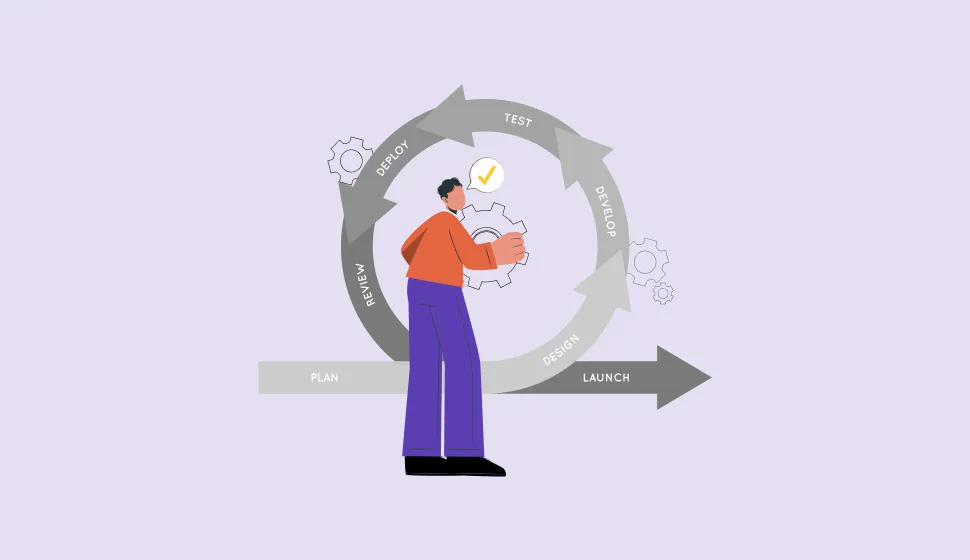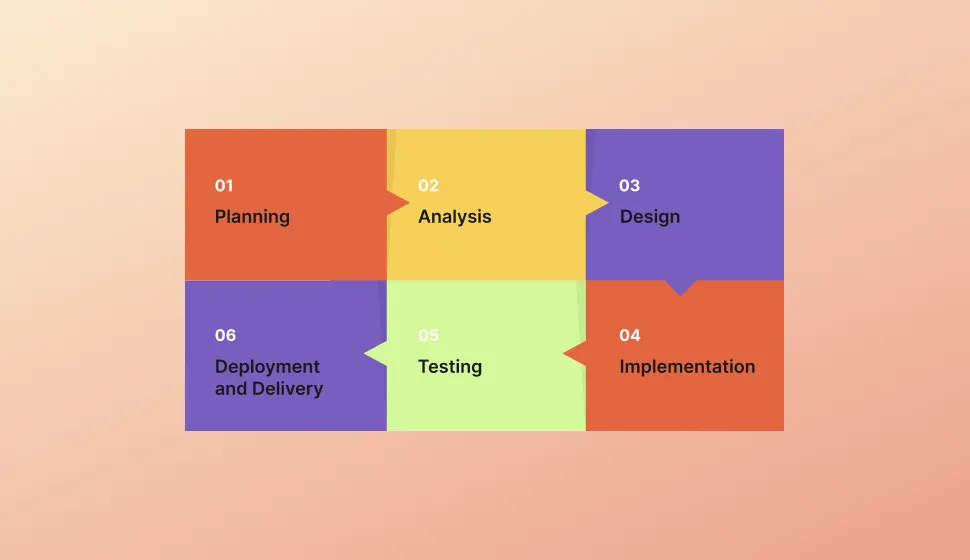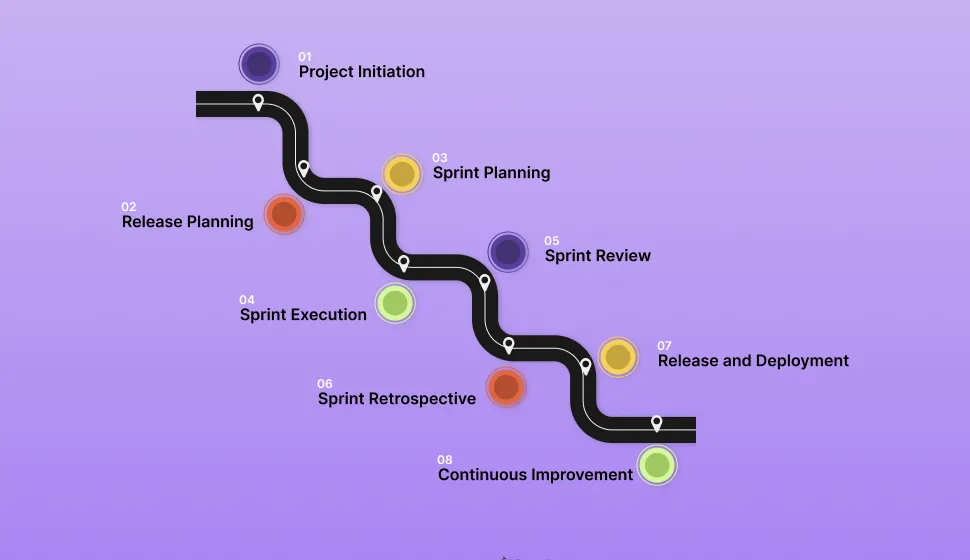Technology

9 min

Discover the ins and outs of the Agile Methodology Development Life Cycle in this comprehensive guide. This blog covers everything from understanding the phases to exploring essential tools and mapping out your roadmap. Whether new to Agile or a seasoned pro, find valuable insights to streamline your development process and drive success.

By Anupam Singh
15 Mar, 2024
Many businesses prioritize the agile methodology, and it's easy to see why. It's like having a secret sauce that boosts productivity and innovation. Around 95% of companies are on board with Agile in some shape or form. Agile teams tend to see a 37% faster profit increase and a 30% higher revenue generation than non-Agile companies. It's not just about numbers; it's about the improved speed, flexibility, and overall vibe that the Agile methodology development life cycle brings.
These stats are more than just figures on a chart; they represent real success stories. Businesses find that Agile approaches help them stay ahead of the game, creating innovative products perfectly in tune with users' needs. And let's not forget the visibility factor—Agile shines a spotlight on the importance of tools and methodologies, especially within the software development life cycle (SDLC). It's all about staying agile in a rapidly changing world.
Agile is a collaborative approach to software development that prioritizes adaptability, flexibility, and customer satisfaction. It emphasizes iterative development, where small, cross-functional teams work in short cycles, known as sprints, to deliver incremental improvements to a product. Agile methodologies, such as Scrum and Kanban, focus on embracing change, continuous feedback, and delivering value early and often.
Agile vs. Waterfall Methodology
| Aspects | Agile | Waterfall |
|---|---|---|
| Approach | An iterative and incremental approach, where development is done in small increments or iterations. | The sequential approach involves development progressing through predefined phases, such as requirements, design, implementation, testing, and maintenance. |
| Flexibility | Embraces change and allows flexibility in project requirements and priorities. | Change is difficult to accommodate once a phase is completed, leading to potential delays and increased costs for changes. |
| Customer Involvement | Encourages active involvement of customers and stakeholders throughout the development process, with regular feedback and collaboration. | Customer involvement typically occurs at the beginning and end of the project, with limited opportunities for feedback and adjustments during development. |
| Risk Management | Identifies and mitigates risks early in development through iterative testing and validation. | Risks are addressed at the beginning of the project, and changes in requirements or priorities later in the project can introduce additional risks. |
| Delivery Time | Allows faster delivery of working software, with incremental releases delivering value to customers early and often. | Longer delivery times are needed as the entire project must be completed before the final product is delivered. |
Agile offers a more flexible and collaborative approach to software development compared to the traditional waterfall methodology. It prioritizes customer satisfaction, adaptability, and continuous improvement, making it well-suited for projects with evolving requirements and dynamic environments.
Imagine you're embarking on a journey to create something incredible – a new software product that will make people's lives easier or businesses more efficient. That's where the Agile product development life cycle comes into play.
At its core, the Agile software development life cycle is like a roadmap that guides you through the entire process of building software. However, unlike traditional approaches that follow a strict, linear path, Agile is about flexibility, collaboration, and adaptability.
Here's a glimpse into what the Agile methodology development life cycle looks like:-
1. Planning: It all starts with a vision – a clear idea of what you want to build and why. During planning, you gather requirements, define goals, and outline the project's scope. It's like mapping out your route before hitting the road.
2. Design: Once you have a plan, it's time to get creative. In the design phase, you bring your ideas to life, sketching out the user interface, creating wireframes, and visualizing how your software will look and feel. It's like crafting the blueprint for your dream house.
3. Development: With the design approved, it's time to roll up your sleeves and start building. The development phase is where the magic happens – developers write code, testers run tests, and the software begins to take shape. It's like watching a blank canvas transform into a masterpiece.
4. Testing: Software is only complete with rigorous testing. During this phase, testers put your software through its paces, identifying bugs and ensuring everything works as intended. It's like putting your creation through stress tests to ensure it's ready for the real world.
5. Deployment: Once your software passes testing with flying colors, it's time to release it into the wild. The deployment phase is where you make your software available to users, whether it's through app stores, websites, or internal networks. It's like unveiling your masterpiece and seeing how people react.
6. Feedback and Iteration: The journey doesn't end there. Agile is about continuous improvement, so you keep listening to feedback, updating, and iterating on your ideas even after your software is released. It's like fine-tuning your creation based on real-world experiences to improve it.
And that, my friend, is the Agile software development life cycle. It's not just a process – it's a journey of creativity, collaboration, and constant evolution. So buckle up because, with Agile, the possibilities are endless.

Agile isn't just a methodology – it's a mindset shift that can transform how your team works and the success of your projects. By embracing Agile, you're not just building software – you're building a culture of collaboration, innovation, and continuous improvement that will propel your business forward.
The origins of Agile development trace back to 1957, when Bernie Dimsdale, John von Neumann, Herb Jacobs, and Gerald Weinberg employed incremental development techniques (now known as Agile) at IBM and Motorola. They recognized its deviation from the Waterfall model but lacked a formal classification.
The modern Agile methodology took shape in 2001 when 17 software development experts convened to explore alternative project management approaches. The Manifesto for Agile software development emerged from this gathering, outlining a flexible, collaborative, and streamlined methodology. The manifesto emphasizes the pursuit of "better ways of developing software" and delineates the foundational principles of Agile.
Some of the top Agile methodologies in software development include the following. Have a look at those-
 1. Scrum: Scrum is one of the most widely used Agile frameworks. It emphasizes iterative development cycles known as sprints, where teams work collaboratively to deliver increments of working software at the end of each sprint. Scrum employs roles such as Product Owner, Scrum Master, and Development Team to facilitate communication and coordination.
1. Scrum: Scrum is one of the most widely used Agile frameworks. It emphasizes iterative development cycles known as sprints, where teams work collaboratively to deliver increments of working software at the end of each sprint. Scrum employs roles such as Product Owner, Scrum Master, and Development Team to facilitate communication and coordination.
2. Kanban: Kanban is a visual Agile methodology focusing on continuous delivery and optimizing workflow. Teams use Kanban boards to visualize their work, limit work in progress (WIP), and prioritize tasks based on demand. Kanban encourages incremental improvements and allows teams to adapt to changing requirements dynamically.
3. Extreme Programming (XP): Extreme Programming is an Agile methodology emphasizing technical excellence and customer satisfaction. XP practices include test-driven development (TDD), pair programming, continuous integration, and frequent releases. Through close collaboration and feedback, XP aims to improve software quality and responsiveness to customer needs.
4. Lean Software Development: Lean Software Development draws inspiration from Lean manufacturing principles to optimize the software development process. It eliminates waste, maximizes value delivery, and fosters continuous improvement. Lean emphasizes principles such as delivering value early, empowering teams, and optimizing the system.
5. Feature-Driven Development (FDD): FDD is an Agile methodology focusing on incrementally delivering features. It divides the development process into five phases: domain object modeling, developing feature lists, planning by feature, designing by feature, and building by feature. FDD emphasizes iterative development and frequent releases to deliver value to customers quickly.
6. Dynamic Systems Development Method (DSDM): DSDM is an Agile methodology development life cycle emphasizing user involvement, iterative development, and frequent delivery. It provides a framework for managing projects within time and budget constraints while ensuring high-quality outcomes. DSDM promotes collaboration between stakeholders and delivery teams to achieve business objectives effectively.
7. Crystal: Crystal is a family of Agile methodologies developed by Alistair Cockburn. It emphasizes the importance of communication, simplicity, and reflection in software development. Crystal methodologies are tailored to suit the needs of different projects based on their size, criticality, and team composition. Crystal promotes transparency, trust, and continuous improvement to deliver successful outcomes.
Ace project management offers diverse approaches to software development, allowing teams to adapt and choose the practices that best suit their project requirements and organizational culture.
 The Agile software development life cycle consists of several key stages or phases that guide the iterative and incremental software development process. Each stage is crucial in delivering high-quality products while maintaining flexibility and responsiveness to changing requirements. Here are the key stages/phases of the Agile development cycle:-
The Agile software development life cycle consists of several key stages or phases that guide the iterative and incremental software development process. Each stage is crucial in delivering high-quality products while maintaining flexibility and responsiveness to changing requirements. Here are the key stages/phases of the Agile development cycle:-
Stage-1: Planning
The planning stage sets the foundation for the entire Agile development process. It involves defining project goals, scope, timelines, and priorities with stakeholders. Agile teams create a backlog of user stories or requirements, the basis for planning sprint cycles.
Stage-2: Analysis
During the analysis phase, Agile teams review and refine the requirements gathered in the planning stage. This involves breaking down user stories into smaller, actionable tasks and clarifying ambiguities. Stakeholders and development teams collaborate closely to ensure a shared understanding of project objectives and deliverables.
Stage-3: Design
In the design phase, Agile teams create the architecture, UI/UX design, and technical specifications for the software product. Design decisions are made iteratively, with frequent feedback loops to validate and refine designs. The goal is to create a flexible, scalable solution that meets user needs and aligns with the project vision.
Stage-4: Implementation
Implementation, also known as the development phase, involves coding and building the software according to the specifications defined in earlier stages. Agile teams work in short iterations or sprints, typically lasting one to four weeks, to deliver incremental functionality. Continuous integration and testing ensure that code changes are integrated smoothly and meet quality standards.
Stage-5: Testing
Testing is integral to the Agile development cycle and occurs concurrently with implementation. Agile teams adopt a test-driven approach, where automated tests are written before or alongside the development of new features. Testing ensures the software meets functional requirements, performs reliably, and remains bug-free throughout development.
Stage-6: Deployment and Delivery
The deployment and delivery phase marks the final stage of the Agile development cycle, where the software is prepared for release to end-users. Agile teams incrementally deploy new features or updates, allowing frequent releases and rapid user feedback. Continuous delivery practices streamline the deployment process, enabling software to deliver quickly and efficiently to production environments.
These key stages/phases of the Agile methodology development life cycle enable teams to deliver high-quality software products iteratively, adapt to changing requirements, and respond effectively to customer feedback. By embracing flexibility, collaboration, and continuous improvement, Agile teams can achieve success in today's dynamic and competitive software development landscape.
The roadmap to the Agile software development life cycle involves a series of iterative steps aimed at delivering high-quality software products while adapting to changing requirements and priorities.
 Project Initiation
Project Initiation
Release Planning
Sprint Planning
Sprint Execution
Sprint Review
Sprint Retrospective
Release and Deployment
Continuous Improvement
By following this Agile methodology development life cycle roadmap, teams can deliver value to customers more rapidly and effectively while fostering collaboration, adaptability, and innovation throughout the development process.
Agile methodologies have proven to be highly adaptable to the remote work era, offering several advantages that align well with the challenges and opportunities of distributed teams.
Agile methodologies prioritize flexibility and adaptability, allowing teams to respond quickly to changes in priorities, requirements, and working conditions. This flexibility is essential in the remote work era, where teams may face disruptions or unexpected challenges.
Agile practices such as short iterations, frequent communication, and adaptive planning enable teams to adjust their approach and stay productive in remote environments.
Agile methodologies emphasize collaboration and communication among team members regardless of their physical location. Remote collaboration tools such as video conferencing, chat platforms, and project management software facilitate real-time communication, document sharing, and task collaboration.
Agile ceremonies such as daily stand-up meetings, sprint planning sessions, and sprint reviews can be conducted effectively in virtual settings, enabling teams to stay connected and aligned.
Agile methodologies promote transparency and visibility into work progress, enabling all team members to understand the status of tasks, identify bottlenecks, and track progress toward goals.
Remote work environments can sometimes lead to a lack visibility and awareness among team members. Agile practices such as Kanban boards, burndown charts, and regular progress updates provide visibility into work progress, helping remote teams stay aligned and focused on priorities.
Agile methodologies empower teams to take ownership of their work and make decisions autonomously. This autonomy is essential for maintaining productivity and morale in remote work environments, where team members may work independently and across different time zones.
Agile principles such as self-organizing teams, cross-functional collaboration, and shared accountability enable remote teams to collaborate effectively and deliver customer value without micromanagement.
Agile methodologies promote a culture of continuous improvement, where teams reflect on their processes, identify areas for enhancement, and experiment with new approaches. In the remote work era, where teams may face unique challenges and constraints, continuous improvement is crucial for adapting to changing circumstances and optimizing productivity.
Agile practices such as sprint retrospectives, feedback loops, and experimentation encourage remote teams to learn from their experiences and evolve their practices over time.
Overall, Agile methodologies provide a robust framework for remote teams to collaborate effectively, adapt to changing conditions, and deliver high-quality work in the remote era. By embracing Agile principles and practices, remote teams can overcome challenges, leverage opportunities, and thrive in today's dynamic and distributed work environments.
Agile methodology development life cycles have gained widespread adoption, enabling organizations to lead their industries. Those that resist risk losing customers and top talent. As an experienced software development company, Quokka Labs prioritizes Agile methodology and adaptability to deliver tailored solutions meeting each client’s specific needs, emphasizing transparent communication and client involvement for exceptional results.
Quokka Labs LLP is the ideal partner if you believe in Agile's potential and seek to leverage it for your product development. With our expertise, steadfast commitment to Agile methodologies, and transparent communication, we're dedicated to surpassing your expectations. Contact us today to discover how we can drive success for your business.
Choosing Best Tech Stack for Web App Development: Performance, Cost, and Scalability
By Dhruv Joshi
5 min read
Top 9 Tech Stacks for Scalable Web Application Development
By Dhruv Joshi
5 min read
Generative AI Implementation Strategy: From Concept to Deployment (Step-by-Step Guide)
By Sannidhya Sharma
5 min read
How to Design a Web App: From Wireframes to Working Prototype
By Dhruv Joshi
5 min read

Technology

7 min
Generative AI is moving fast into enterprises, from banks to hospitals to government agencies. Adoption is rapid, but security planning lags. Unlike traditional systems, these models can be exploited through prompt injection, poisoned data, or manipulated to leak sensitive information. They are also misused for phishing, deepfakes, and malicious code.


Technology

7 min
AI-powered Web Application Firewalls (WAFs) go beyond static rules by using machine learning, anomaly detection, and predictive analysis to block zero-day threats, reduce false positives, and protect APIs at scale. Unlike traditional WAFs, they self-learn, adapt in real time, and cut operational costs while improving compliance and trust.


Technology

5 min
AI is redefining mobile app security by transforming how threats are detected, tested, and prevented. From continuous monitoring and fraud detection to compliance with regulations, AI ensures apps remain resilient against modern risks. This means safer apps, protected users, and stronger businesses. Investing in AI-driven security today builds trust, drives growth, and secures long-term competitive advantage.


Feeling lost!! Book a slot and get answers to all your industry-relevant doubts